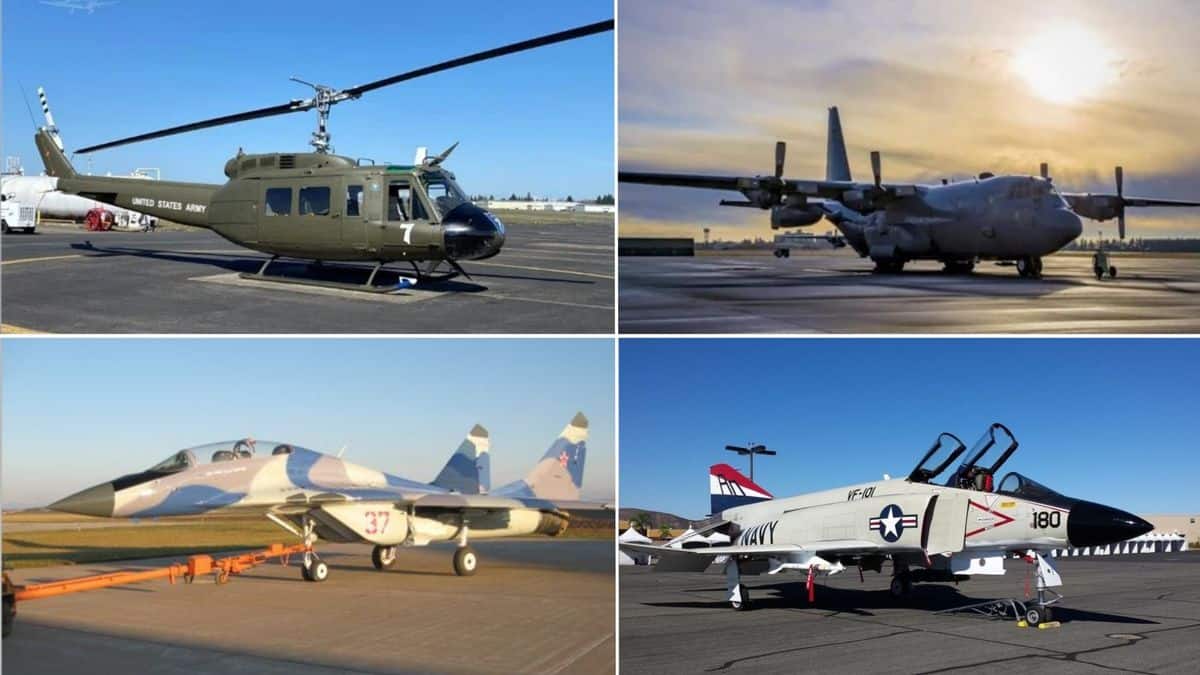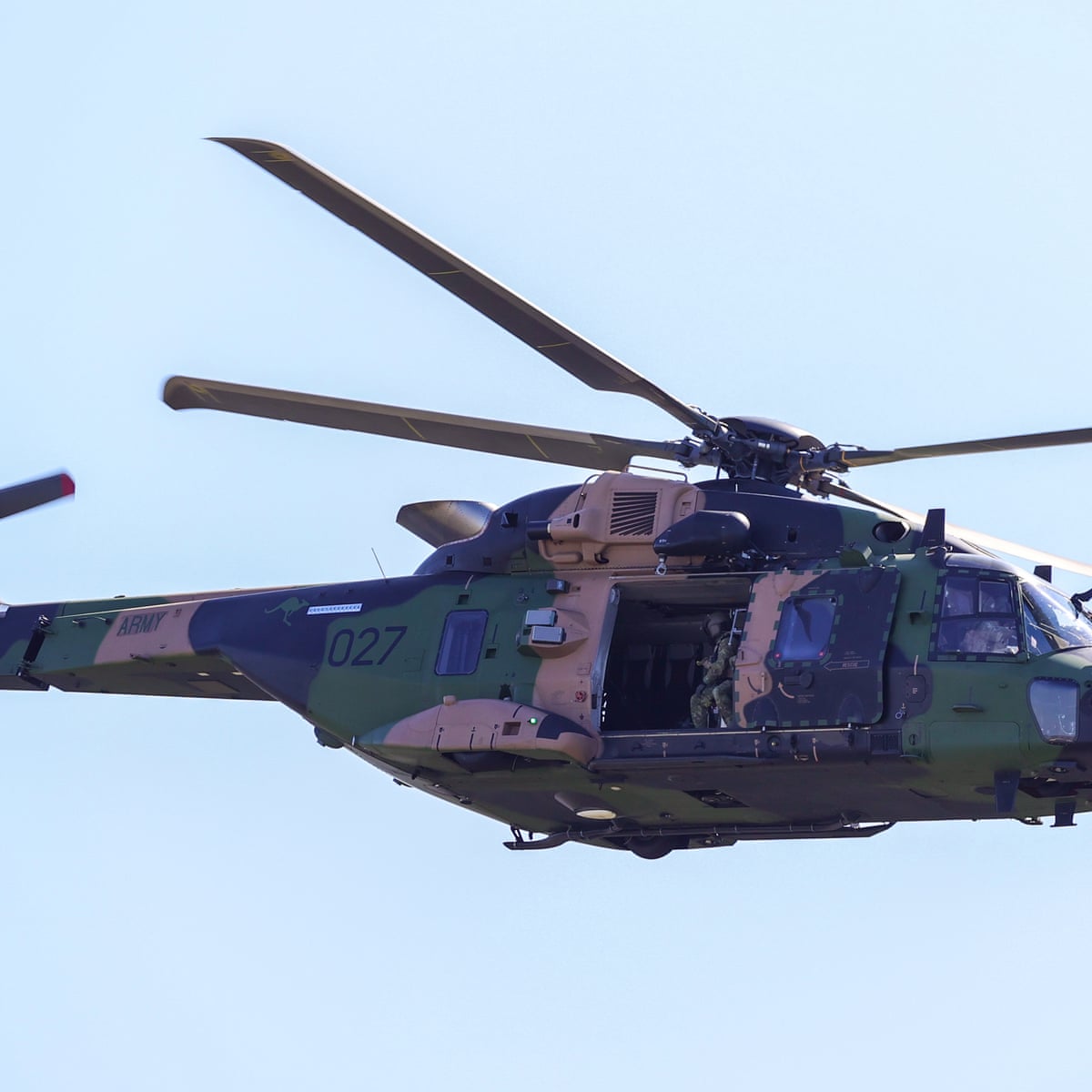Old Military Helicopters - The Bell UH-1 Iroquois (nicknamed "Huey") is a general-purpose military helicopter designed and manufactured by the American aerospace company Bell Helicopter. It was the first member of the prolific Huey family and the first turbine-powered helicopter in service with the United States military.
The development of the Iroquois began in the early 1950s; this was a major incentive issued by the United States Army for a new medical evacuation and utility helicopter. First flying on October 20, 1956, the Bell 204 was warmly received, particularly for its single-turboshaft engine performance relative to its piston-engined counterpart. The first production contract for 100 HU-1A was issued in March 1960. In response to criticism of the rotorcraft's capabilities, Bell quickly developed a series of models equipped with more powerful engines; Compared to the prototype Lycoming YT53-L-1 (LTC1B-1), which produced 700 shp (520 kW) in 1966, the 1,400 shp (1,000 kW) Lycoming T53-L-13 was installed on some models under construction. An enlarged version of the Iroquois, first flown in August 1961, was developed in response to the Army's request for a version that could accommodate more troops. Other changes will include the use of all-aluminum construction, the adoption of a rotor brake, and alternative motors.
Old Military Helicopters

Iroquois were first used in combat operations during the Vietnam War, and the first examples were deployed in March 1962. It was used for a variety of purposes, including ground support, air strikes, cargo transport, air medical evacuation, search and rescue, electronic warfare, and ground attack missions. Armed Iroquois warships carried a variety of weapons, including rockets, grade launchers, and machine guns, and were often modified to suit specific operations in the field. The United States Air Force also deployed its Iroquois to Vietnam, using it in reconnaissance operations, psychological warfare, and other support roles. Armed air services of other countries, such as the Royal Australian Air Force, sent their own Iroquois to Vietnam. In total, about 7,000 Iroquois were deployed in the Vietnamese theater, of which more than 3,300 are believed to have died. The Iroquois saw combat deployments in a variety of other conflicts, such as the Rhodesia Bush War, the Falklands War, the war in Afghanistan, and the 2007 Lebanon conflict.
Military Helicopters August 2022
The Iroquois was originally called HU-1, hence the nickname Huey, which remained in common use despite being officially renamed UH-1 in 1962.
Various variants and improvements of the Iroquois were produced. The Bell AH-1 Cobra, a special attack helicopter, is derived from the UH-1 and has a high degree of commonality. The Bell 204 and 205 are versions of the Iroquois for the civilian market. In response to some customer requests, a twin-engine model, the UH-1N Twin Huey, was also produced in the late 1960s; The Bell UH-1Y Vom, a four-blade derivative, was also developed in the early 21st century. In US Army service, the Iroquois was phased out after the release of the Sikorsky UH-60 Black Hawk and Eurocopter UH-72 Lakota, but hundreds of others were still in use more than 50 years after the breed was introduced. More than 16,000 Iroquois have been produced since 1960.
In 1952, the U.S. Army determined that a new helicopter was needed to serve as a medical evacuation (MEDEVAC), instrument training, and general service aircraft. The Army decided that CART helicopters were too large, insufficient, or too complex to be easily maintained. In November 1953, the revised military requirements were submitted to the Department of the Army.
Twenty companies submitted their designs for their contracts, including the Model 204 Bell helicopter and the turbine-powered version of the H-43, a gunboat.
Sting In The Tail: Why Australia's Taipan Helicopter Purchase Was A Debacle From The Start
On February 23, 1955, the Army announced its decision, selecting Bell to evaluate three copies of the Model 204, named the XH-40.
Powered by a prototype Lycoming YT53-L-1 (LTC1B-1) engine producing 700 shp (520 kW), the XH-40 first flew on October 20, 1956.
In Fort Worth, Texas, Bell's lead test pilot, Floyd Carlson, is at the controls. The Army ordered six YH-40 service test helicopters before the first flight. Two more prototypes were completed in 1957.

In March 1960, the Army awarded Bell a production contract for 100 aircraft, designated "HU-1A" and officially named the Iroquois after Native American nations.
Military Aircraft You Can Actually Buy
The helicopter developed a nickname derived from the name HU-1 and pronounced "Huey". The reference became so popular that Bell began naming helicopter anti-torque pedals.
The nickname was retained after September 1962, when all models were renamed UH-1 under a unified Department of Defense (DOD) designation system.
While praising the helicopter's progress over piston-engined helicopters, Army reports from service testing of the YH-40 indicated that the production T53-L-1A engine, which produced 770 (570 kW) maximum continuous shaft horsepower, was inadequate. . . )
When the Army took delivery of the first UH-1A, it showed the need for an improved follow-up model. In response, Bell proposed the UH-1B, which produces a 960 shp (720 kW) Lycoming T53-L-5 engine and a long cabin that can accommodate rescued passengers or four stretchers and a paramedic. Army tests of the UH-1B began in November 1960, and the first production aircraft was delivered in March 1961.
Australia Pays To Maintain Trouble Plagued Taipan Helicopters No Longer Being Used By Navy
Bell began developing the UH-1C in 1960 to correct the aerodynamic shortcomings of the armed UH-1B. Bell fitted the UH-1C with a 1,100 shp (820 kW) T53-L-11 engine to provide the power needed to lift all weapon systems in use or in development. The military has equipped almost all UH-1B aircraft with the same gene. A new rotor system has been developed for the UH-1C to increase airspeed and reduce wing stall delay during dive maneuvers. Improved rotors provide improved maneuverability and a slight increase in speed.
Bell engineers needed to design a new tail boom for the UH-1C for more power and a larger diameter rotor. It includes a long tail boom, tail rotor pylon and a wide beam vertical aileron on larger synchronized elevators.
Bell also introduced a dual hydraulic control system for redundancy, as well as an advanced inlet filter system for dusty conditions found in Southeast Asia. UH-1C fuel capacity has been increased to 242 US gallons (920 liters) and gross weight to 9,500 lb (4,309 kg), giving a nominal payload of 4,673 lb (2,120 kg). . Production of the UH-1C began in June 1966 with a total of 766 aircraft, five for the Royal Australian Navy and five for Norway.

While earlier "short-bodied" Hueys had been successful, the Army wanted a version that could carry more soldiers. Bell's solution was to lengthen the HU-1B body by 41 inches (104 cm) and use the extra space to fit four seats outside the muzzle, next to the transmission. Seating capacity increased to 15 including crew.
Old Helicopter Images, Stock Photos & Vectors
The sliding side doors of the previous model were replaced by a single window with large doors with two windows, as well as a small hinged panel with an optional window that provides access to the cabin. The doors and hinged panels were quickly removed, allowing the Huey to fly in a "doors closed" configuration.
Seve pre-production/prototype aircraft was delivered to Edwards Air Base for testing from March 1961. The 205 was initially equipped with a Lycoming T53-L-9 engine with a 44-foot (13.4 m) main rotor and 1,100 shp. (820 kW). The rotor was up to 48 feet (14.6 m) long with a 21-inch (53 cm) beam. The tail boom has also been stretched to accommodate the longer rotor blades. Overall, the changes have resulted in a total weight capacity of 9,500 lb (4,309 kg). The Army placed 205 production orders with T53-L-11 engines for multi-fuel capacity in 1963.
In 1966 Bell installed a 1,400 shp (1,000 kW) Lycoming T53-L-13 engine to provide more power to the helicopter. The pitot tube was moved from the nose to the cockpit roof to avoid damage during landing. Production models of this configuration were designated UH-1H.
In 1962, the United States Marine Corps held a competition to select an attack support helicopter to replace the Cessna O-1 fixed-wing aircraft and the Kaman OH-43D helicopter. The winner was the UH-1B, already serving in the Army. The helicopter was designated UH-1E and modified to meet maritime requirements. Major changes include the use of all-aluminum construction for corrosion resistance,
List Of United States Military Helicopters
Radios compatible with Marine Corps ground frequencies, onboard rotor brake to quickly stop the rotor during shutdown, and a roof-mounted rescue winch.
The UH-1E first flew on 7 October 1963 and deliveries began on 21 February 1964; A total of 192 Iroquois were completed from this model.
Due to the realities of Bell's production line, the UH-1E was produced in two different versions, both with the same UH-1E designation. The first 34 aircraft built were primarily UH-1B airframes with Lycoming T53-L-11 engines producing 1,100 shp (820 kW).

When Bell switched production to the UH-1C, UH-1E production benefited from the same changes. The Marines then amplify the UH-1E genes to Lycoming T53-L-13 1,
What It's Like To Fly The U.s. Military's Most Heavily Armed Attack Helicopter
Military base homes, san francisco old military base, dui on military base, nearest military base, old military base for sale, old military base in san francisco, grafenwoehr military base, military base, buy old military base, camp lejeune military base, lejeune military base, military base housing allowance
0 Comments